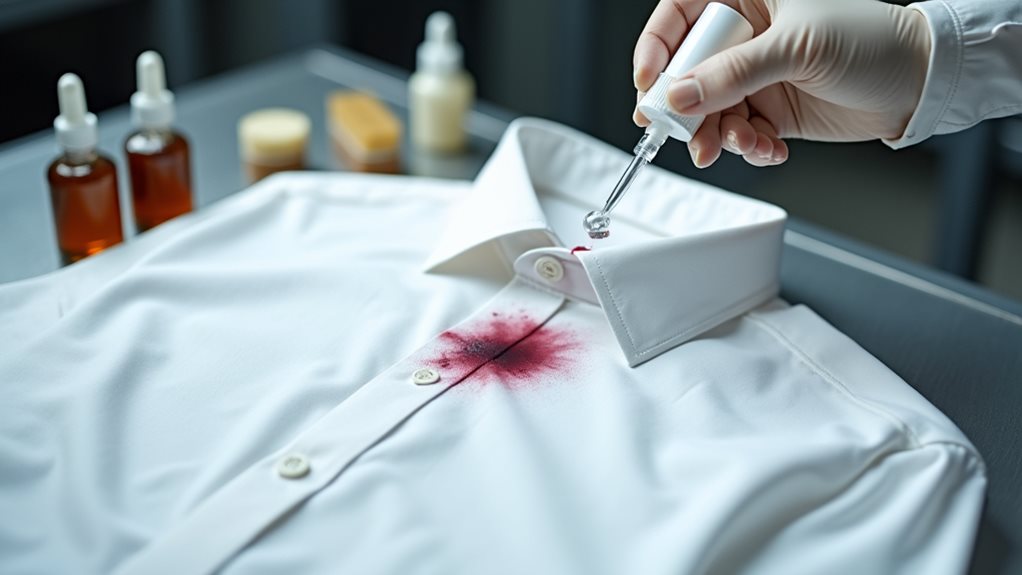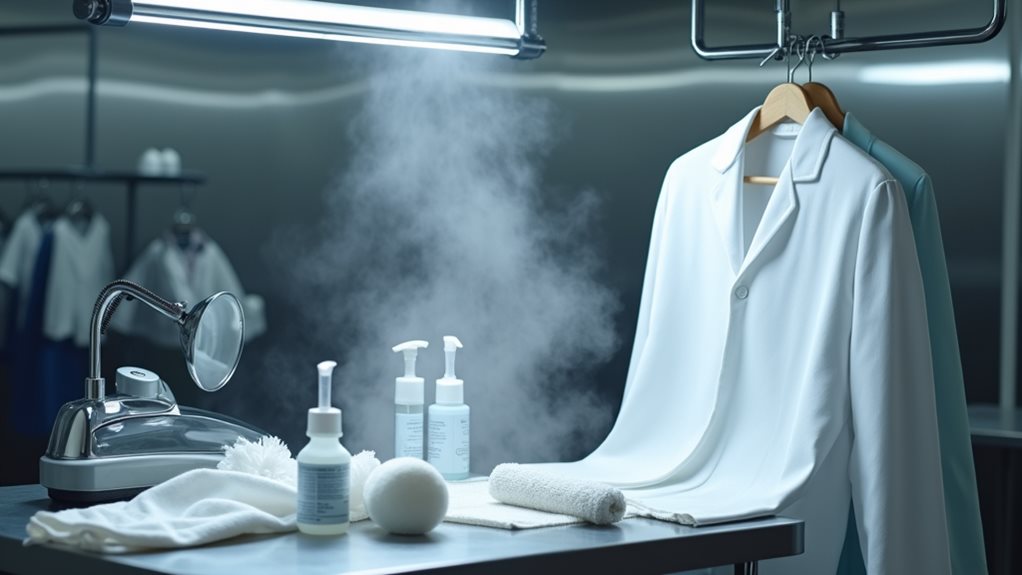Dry cleaning transforms your delicate garments through five careful steps that’ll save your favorite pieces from permanent damage. First, trained attendants inspect and tag each item, identifying stains and noting special care requirements. Next, they pre-treat stubborn spots with specialized solvents before your clothes enter the main cleaning cycle, where gentle chemical solvents work at cool temperatures instead of harsh water. After post-spotting any remaining stains and making minor repairs, they’ll press and package your garments perfectly—and there’s fascinating science behind each stage.
Inspection and Tagging of Garments
When you first bring your favorite silk blouse or wool suit to the dry cleaner, you might think the cleaning process starts immediately, but there’s actually a crucial detective work phase that happens first.
The inspection and tagging stage is where trained attendants become garment investigators, carefully examining every inch of your clothing for stains, damage, and those sometimes-cryptic care instructions.
Trained dry cleaning attendants transform into garment detectives, meticulously inspecting every fiber for stains, damage, and care requirements.
They’ll note missing buttons, tiny tears, or that mysterious spot you forgot about, determining what pre-treatment each piece needs.
Your garments receive unique identification tags with your name and specific care requirements, facilitating proper tracking throughout their cleaning process.
This meticulous attention to detail prevents mix-ups and guarantees your clothes maintain their quality and appearance.
During this inspection phase, attendants also identify oil-based stains that will require the specialized chemical solvents used in dry cleaning rather than traditional water-based cleaning methods.
Pre-Spotting Treatment for Stains

After your garments receive their thorough inspection and personalized tags, the real stain-fighting magic begins with pre-spotting treatment, a targeted attack that would make any superhero proud.
During this vital phase, dry cleaning professionals carefully select specialized chemical solvent options based on what they discovered in the inspection phase – whether you’re dealing with stubborn oil-based marks or protein-based disasters from last night’s dinner mishap 🍝.
These targeted solutions work like tiny molecular warriors, weakening the stain’s grip on your fabric before the main dry cleaning process even starts.
This effective pre-spotting step dramatically improves your garment’s overall cleanliness while preventing remaining stains from staging an unwelcome comeback, guaranteeing your clothes emerge looking fresh and professionally restored.
The pre-spotting treatment is particularly crucial for delicate fabrics like silk and wool that could be damaged by harsh washing methods.
The Dry Cleaning Cycle

Once the pre-spotting warriors have done their preliminary work, your garments initiate their main adventure through the actual dry cleaning cycle, where they’ll take a luxurious bath in chemical solvents instead of water – think of it as a spa day for fabrics that would absolutely panic at the sight of H2O 💧.
The cleaning machines gently rotate your delicate fabrics in perchloroethylene or hydrocarbon solvents for 8-15 minutes at cool 30°C temperatures, guaranteeing they remove stains without causing fabric distortion.
After this thorough cleansing, there’s a rinse with fresh solvent that recovers 99.99% of the chemicals used.
Finally, the drying process tumbles your clothes in warm air at 140-145°F, evaporating any lingering solvents.
Some eco-conscious cleaners have adopted liquid CO2 as an environmentally friendly alternative solvent that provides the same gentle cleaning power without the environmental concerns of traditional chemicals.
Post-Spotting and Quality Control

The dry cleaning expedition doesn’t end with that solvent spa treatment, because your garments now face their final exam through post-spotting and quality control – imagine it as the difference between getting a rough draft back from your English teacher versus receiving that polished, A+ paper you’re actually proud to show your parents 📝.
During this vital phase, professionals scrutinize every inch of your clothing, hunting down stubborn stains that somehow survived the cleaning cycle, like that one friend who refuses to leave the party. They’ll apply specialized spotting solutions to tackle these persistent troublemakers, guaranteeing your garments meet their high standards.
Minor repairs get addressed too – loose buttons, small tears – because returning clothes in pristine condition isn’t just their job, it’s their reputation on the line. This meticulous attention to detail is especially crucial for delicate fabrics like silk and wool, which require chemical solvents rather than water-based cleaning to maintain their texture and appearance.
Finishing and Final Preparation

While your clothes have survived their chemical bath and passed their quality inspection, they’re still looking about as polished as you do rolling out of bed on a Monday morning – which is where the finishing and final preparation stage swoops in like that friend who’s amazing at makeup and somehow transforms you into a presentable human being ✨.
Your dry cleaning service now begins the meticulous pressing process, using steam and heat to eliminate every stubborn wrinkle while carefully shaping your garments back to perfection.
Meanwhile, any remaining solvents evaporate completely through air drying techniques, often using mannequins to maintain that crisp, original fit you remember loving.
The final inspection guarantees absolute cleanliness, double-checking that removing stains was successful before your clothes receive their finishing techniques and protective packaging for delivery.
This comprehensive pressing and steaming process ensures your garments are restored to their original appearance, completing the dry cleaning process that began with inspection and tagging.




